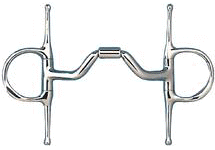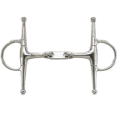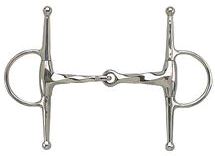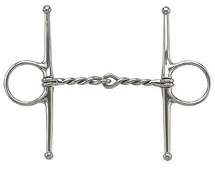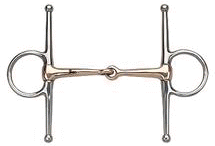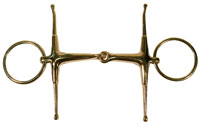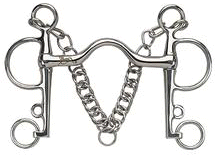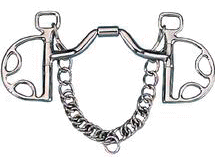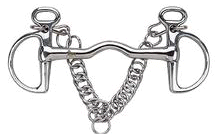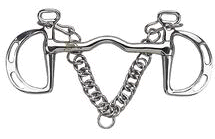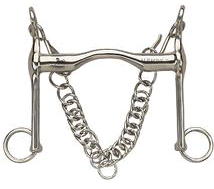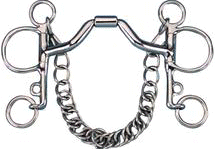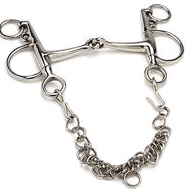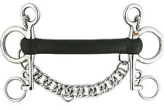|
ENGLISH BITS |
|
|
SNAFFLES
Snaffles work with direct pressure with a straight line along the reins. The connection between the reins and the mouthpiece are rings of different shapes which are also attached to the bridle. Rein action is applied to either one side of the bit or the other. Snaffle mouthpieces vary from solid to broken, from smooth to twisted, from rubber to copper, from narrow to thick. Snaffles acts on the mule=s tongue and lips. The snaffle allows great influence of the mule=s lateral flexion. If a leather curb is used with the snaffle it is attached above the reins on the snaffle ring and has no leverage action when the reins are used. A leather curb simply keeps a snaffle from being pulled through the mule=s mouth. All snaffle bits have the same action: asking the horse's head to come up and in towards the rider's hands along the line of the reins. THAT IS ALL THAT THEY DO. They do this by resting on the bars (but not acting on them if correctly fitted), applying a small amount of pinpoint pressure on the tongue, and predominantly acting on the corners of the mouth. Various modifications introduce small nuances of difference, but basically ALL snaffle-type bits have the same action. LOOSE RING SNAFFLES Hollow Mouth French Training
Snaffle Bit Loose Ring Hollow Mouth Bit
Solid Rubber Dog Bone Bit
Oval Mouth Loose Ring Bit
DEE RING SNAFFLES D-Bit. Unless the shanks of the D-bit are very long (the straight part of the cheek piece that the mouthpiece is attached to), they behave exactly as an eggbutt. Dee Ring Bit
Solid Mouth Dr. Bristol Bit
Solid Mouth Copper & Stainless Steel Roller Bit
Solid Mouth Barrel Bit
Jointed Rubber Covered Mouth Bit
Hunter Dee with French Link Bit EGGBUTT SNAFFLES This bit was invented for economic reasons. It used to be very expensive to smooth out the holes the rings passed through in a loose ring snaffle (and if they weren't smoothed out, the horse developed irritated/pinched lips), so someone had the great idea of fixing the joint away from the lips to avoid the pinching. They carry no advantage over a correctly fitted loose-ring snaffle IN GOOD HANDS. With a loose-ring, a small rein aid results in movement of the bit, so that the horse can respond to a lighter, more invisible aid. However, with a novice rider, this means that EVERY wobble on the rein is transmitted to the horse. With a fixed cheek piece, only the "hard" wobbles go to the horse's mouth. Eggbutt Bit Correctional Port Barrel Bit
Curved Mouth French Link Eggbutt Bit
Slow Twist Bit FULL CHEEK SNAFFLES Full Cheek. The bit action itself is the same, but now there are cheek pieces to give some advantages: keepers prevent the horse from turning the bit over in his mouth (useful in young horses), and the cheek pieces themselves supply some direct rein aid and can prevent a horse from evading by crossing his jaw. Ported Barrel Bit - Copper Inlay
Solid Mouth Dr. Bristol Full Cheek Bit
Solid Mouth Slow Twist Bit
Single Twisted Wire Full Cheek Bit
Copper Mouth Full Cheek Bit HOLLOW MOUTH FULMER
|
CURBS Curb bits are any shanked bit using leverage. The leverage is established by the extensions called shanks and the addition of a curb chain that lies along the chin groove of the mule. The shanks which extend below the mouth piece and attached to the reins define the severity by their shape and length. The curb chain is attached to the bit at or above the mouthpiece and squeezes the chin groove as the reins engage the mouth piece. Curb chains can be made of single or double chain, rawhide or leather. Curb bits may have mouthpieces that are straight, ported, arched or jointed. The rein action of the curb bit affects the mule=s tongue, bars, chin and poll. With a very high port it also affects the hard pallet of the mule=s mouth. A curb is a bit with shanks and a chain or strap under the jaw that acts as a fulcrum for the lever action of the bit in the horse's mouth. It puts pressure on the bars, tongue and jaw, the amount depending on the design of the bit (longer shank -- more pressure on jaw, higher port -- more pressure on roof of mouth) and the amount of contact you keep with the reins. It raises a horse's head and neck and can make him tuck his nose. Used poorly on a horse that has not learned how to give to a bit, it will cause "stargazing" or a high head and stretched out nose. A curb bit can be very painful to a horse; a light pull on the reins with a long shanked curb is much more severe than a heavy pull on the reins with a snaffle. Kimberwicke bits Kimberwicke bits are essential a D ring modified with a curb chain. It combines functions of both the curb and snaffle. They are an adaptation of the pelham with either straight, straight with port, mullen or jointed mouth pieces. Ring cheek pieces are usually about 2 1/2" across and may have slots in the rings (called Uxeter kimberwickes) to allow for two different rein positions rather than the regular sliding rein action. Shown here, the Uxeter Kimberwickes are versatile bits with upper and lower reins slots for English riding disciplines. Reins in the upper rein slots will increase pressure on the tongue, while reins in the lower slots will increase leverage and apply curb chain pressure. Kimberwick Ported Barrel Bit -
Copper Inlay Standard Rings Bit
Uxeter Bit WEYMOUTH Weymouth. This is a ported curb bit with a sliding cheek. The problem with the port is that it is too narrow for the vast majority of horses' tongues to fit, and therefore pinches the tongue. This may cause tongue problems in some horses. Another problem with this bit is that the sliding cheeks introduce a sloppiness/looseness that is counter to the precision desired from the curb. Dressage Weymouth
PELHAM Pelham bits have shanks and are most effective when used with two sets of reins attached to give the effect of both snaffle and curb. Pelham Ported Barrel Bit with
Copper Inlay Jointed Eggbutt Pelham Bit
Rubber Tom Thumb Pelham Bit
Fixed Cheek Polo Pelham Bit
|













